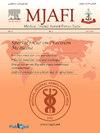A review of vaccines and antivirals against human poxviruses with special emphasis on mpox virus
Q2 Medicine
引用次数: 0
Abstract
A significant proportion of the global population with waning immunity to smallpox is susceptible to poxviruses. Zoonotic orthopoxviruses are re-emerging and emerging worldwide, including the mpox virus, vaccinia virus, and cowpox virus. Knowledge gaps exist regarding reservoir hosts for many poxviruses, modes of transmission, zoonotic potential, and vaccine effectiveness. The precise natural reservoir of many emerging zoonotic infections such as vaccinia virus, cowpox virus, and mpox virus is unknown which is a significant barrier to the development of appropriate public health preventive measures, including vaccines and antivirals. Accurate diagnosis of the pox virus causing lesions in animals is essential for proper veterinary preventive measures including vaccinating noninfected neighboring herds. Adopting strict personal hygiene among farm workers, butchers, and veterinarians will prevent the spread from animals to humans. The availability of specific anti–pox virus medications is limited, and many candidate drugs are undergoing clinical trials. Management of any health emergency requires regional collaboration and efficient public health leadership. Antivirals or vaccines to manage many pox viruses are inaccessible in endemic countries, home to many rare zoonotic pox viruses.
人痘病毒的疫苗和抗病毒药物综述,特别强调m痘病毒
全球对天花免疫力下降的人口中有很大一部分容易感染痘病毒。人畜共患正痘病毒正在世界范围内重新出现和出现,包括痘病毒、牛痘病毒和牛痘病毒。在许多痘病毒的宿主、传播方式、人畜共患的可能性和疫苗有效性方面存在知识空白。许多新出现的人畜共患病感染,如牛痘病毒、牛痘病毒和m痘病毒的确切自然宿主尚不清楚,这是制定适当的公共卫生预防措施(包括疫苗和抗病毒药物)的一个重大障碍。准确诊断引起动物病变的痘病毒对于采取适当的兽医预防措施至关重要,包括为未感染的邻近畜群接种疫苗。对农场工人、屠夫和兽医采取严格的个人卫生措施,可以防止动物传染给人类。特异性抗痘病毒药物的可用性是有限的,许多候选药物正在进行临床试验。任何突发卫生事件的管理都需要区域合作和有效的公共卫生领导。在存在许多罕见人畜共患痘病毒的流行国家,无法获得治疗许多痘病毒的抗病毒药物或疫苗。
本文章由计算机程序翻译,如有差异,请以英文原文为准。
求助全文
约1分钟内获得全文
求助全文
来源期刊

Medical Journal Armed Forces India
Medicine-Medicine (all)
CiteScore
3.40
自引率
0.00%
发文量
206
期刊介绍:
This journal was conceived in 1945 as the Journal of Indian Army Medical Corps. Col DR Thapar was the first Editor who published it on behalf of Lt. Gen Gordon Wilson, the then Director of Medical Services in India. Over the years the journal has achieved various milestones. Presently it is published in Vancouver style, printed on offset, and has a distribution exceeding 5000 per issue. It is published in January, April, July and October each year.
 求助内容:
求助内容: 应助结果提醒方式:
应助结果提醒方式:


